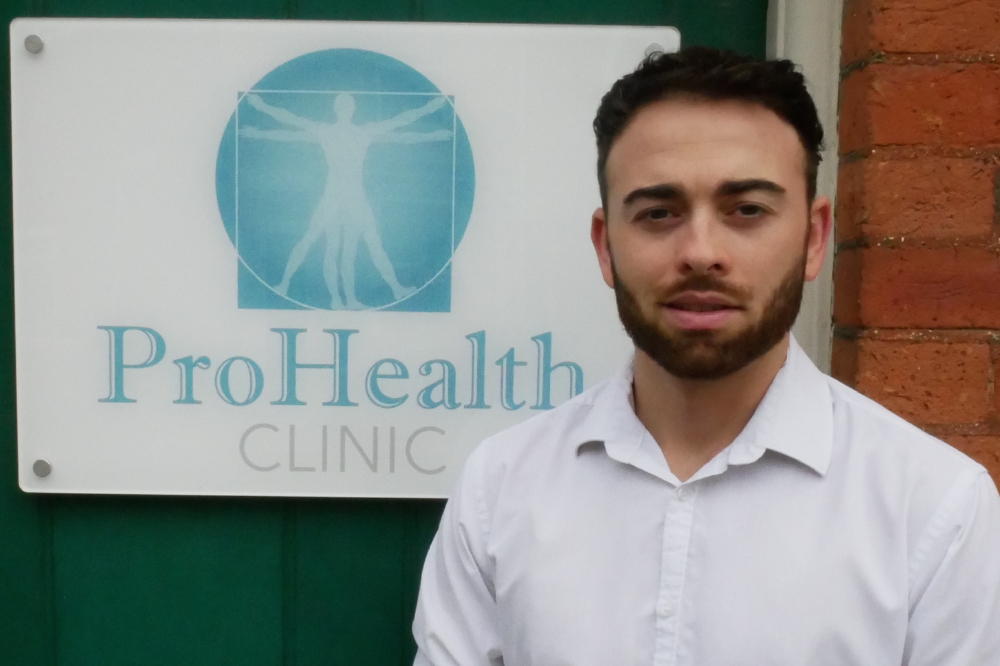By Oliver Eaton, ProHealth Clinic

Oliver Eaton
Sciatica is defined as pain in either one or both legs with possible tingling, numbness or weakness caused by the pinching of the sciatic nerve along its pathways.
There are a variety of symptoms associated with sciatica:
- Pain that is constant in only one side of the buttock or back of the leg
- Pain that is worse when sitting
- Numbness, tingling, burning or weakness in the buttocks or legs
- The symptoms can be constant or develop when moving
- A sharp pain that may make it difficult to stand up or walk
- Sharp shooting pain that travels down the leg in a line, often into the foot and toes.
Lumbar herniated disc
Herniated discs occur when the gel-like material inside the disc pushes against the outer coating, causing it to bulge. This bulge can then push against the nerve that runs alongside it.
Degenerative disc disease
Discs, alongside cartilage in the body don’t have a blood supply. This means a disc’s ability to repair and regenerate isn’t as efficient as a muscle’s ability, for example. As we age, the volume of fluid in the disc lessens, weakening the structure, leaving it vulnerable to bulging out against a nerve.
Lumbar spinal stenosis
Stenosis occurs when the space between the spinal joints is narrowed. You have nerves that travel next to this space, and they can often become irritated as the space between the joints lessens.
Piriformis syndrome
One of the most common causes of sciatica is when the sciatic nerve becomes pinched by the piriformis muscle. The muscle itself is one of the deep buttock muscles and in 30% of the population the nerve runs directly through it, leaving these individuals more vulnerable to it pinching.
Sacroiliac joint dysfunction
When the sacroiliac joint is irritated it can irritate the lowest lumbar nerve as it runs alongside the joint, causing debilitating sciatic type pain as the joint is moved with minor movements such as walking.
Pregnancy
The weight of the baby can cause many of the muscles that surround the sciatic nerve to tighten up around it, causing symptoms of sciatica. Also, during the third trimester of pregnancy a hormone called relaxin is released. This hormone relaxes the ligaments in the pelvis to allow for the baby to travel through easily during labour. The relaxing of these ligaments can often cause the pelvis to misalign, which can pinch some of the nerves that run through that area.
Muscle strain
If any of the muscles along the pathway of the sciatic nerve suffer a strain and it isn’t treated properly, then it can cause scar tissue to form over that strain. This scar tissue can potentially put pressure on the sciatic nerve.
Natural Sciatica Treatments
Heat/ice
Heat and ice can help for both acute and chronic cases of sciatica. If the sciatica is a result of an acute injury, straining a muscle for example, then you can use a procedure called contrast bathing. This involves placing ice or a cold compress over the area for 10 minutes and then immediately after placing heat over the area for 10 minutes. This can be repeated twice an hour if needed.
Osteopathy
Osteopathy is a system of alternative medicine that helps both to identify and address the root cause of an individual’s sciatica. Several orthopaedic tests will be used to find out where the sciatic nerve is being pinched and then a combination of massage, stretching and gentle manipulation is used to take the pressure off the nerve.
Acupuncture
If the cause of an individual’s sciatica is the result of tension in the leg and muscles tightening up around the nerve, then acupuncture can be effective at helping reduce this tension. Hair-thin needles (which are usually not felt) are inserted into the affected muscles.
Massage therapy
Again, if an individual’s sciatica is caused by tight muscles around the sciatica nerve then massage therapy can be an effective way of releasing those muscles, creating an environment for the sciatic nerve to operate without any irritation.
Osteopathy, Acupuncture and Massage have all been approved by the NICE Guidelines (National Institute for Health and Care Excellence). Both NHS and private doctors in the UK use these guidelines to inform them of appropriate treatments.
ABOUT THE AUTHOR
Oliver Eaton is a qualified and registered osteopath, Medical Acupuncturist and Musculoskeletal Injection Therapist. He specialises in the treatment of sciatica, arthritis and headaches/migraines with patients travelling from across the UK and Europe for treatment.
Much of Oliver's specialties were learnt through personal experience; suffering from a series of chronic conditions from which he made a full recovery using alternative medicine approaches. This sparked his passion for specialising in the treatment of patients with chronic pain. As one of the leading practitioners in his field on Harley Street, he has built his reputation on achieving results with patients who had previously had no success elsewhere.
Oliver uses the latest diagnostic approaches to help identify the root causes of an individual’s sciatica. Once identified, he is able to use osteopathy or acupuncture to both help to resolve the symptoms and prevent them from returning, without the use of medication.
Website: www.prohealthclinic.co.uk
Facebook: https://www.facebook.com/ihealthinjury/

